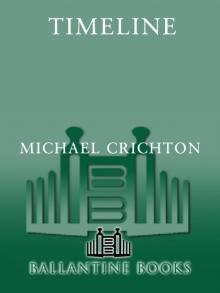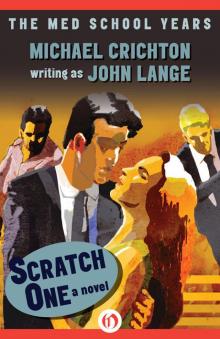- Home
- Michael Crichton
Five Patients Page 9
Five Patients Read online
Page 9
Page 9
It took less than three months for anesthesia to gain wide acceptance in medicine. It took more than thirty years for antisepsis to be accepted. Why? Both discoveries addressed themselves to equally important problems-if anything, infection was an even greater problem than pain. And both techniques, though primitive, certainly worked. What accounts for the difference in speed of acceptance?
Scientific understanding is not part of it. At the time the two innovations were proposed, neither could be explained. And though we now understand antisepsis, we still cannot explain why anesthetic gases kill pain.
Nor is diffusion of information a problem. News of antisepsis spread as quickly as news of anesthesia. Listers techniques were widely and hotly debated in every Western country.
The answer seems to lie with medicines capacity for dealing with individuals rather than groups. Anesthesia was dramatic, it produced a positive effect, and it could be seen working in the individual. On the other hand, antisepsis was passive, not dramatic, and negative in the sense that it tried to prevent an effect, not produce one. It was common in the early days of antisepsis for a skeptical surgeon to half-heartedly try the lengthy, exasperating techniques on one or two patients, find that the patients still became infected, and generalize from this experience to conclude the system was worthless. Nor can one really hold this against them, for a modern understanding of individual and group effects-the notion, for example, of a "controlled clinical trial" in all its statistical ramifications-is very recent indeed.
Nonetheless, antisepsis eventually became accepted in principle and thereafter followed a string of contributions to sterile operative technique. William S. Halstead, the Johns Hopkins surgeon, is credited with introducing rubber gloves for surgery in 1898. Special gowns to replace street clothes came at the turn of the century. Masks were not common until the late 1920s.
Ultimately, antibiotics provided the final powerful tool. Thus, in the space of a century, surgical mortality, which was generally 80 per cent at the time of the Civil War, was cut to 45 per cent by Listerian methods, and slowly cut even further in ensuing years, until it is now about 3 per cent in most hospitals.
Ways to reduce the percentage to zero are being explored. In recent years, the evolved ritual of timed scrubs, sterile gowns, rubber gloves, and masks has been criticized. Various studies have indicated that scrubbing does not clean the skin, but just loosens the bacteria on the hands, making them more mobile; that one quarter of all gloves have holes in them; that modern gowns are permeable to bacteria, especially if they become wet (as they often do in the course of operation); that doorways sealing off operating rooms do not prevent spread of bacteria but serve as collecting places for them. Such studies are too conflicting at present to see a clear trend, but it is likely that the ritual will be strongly modified in coming years.
Surgeons themselves tend to be almost complacent about the studies, largely because postoperative infection is no longer a major problem. In fact, the most common early, immediate, direct cause of death from surgery is not the operation but the anesthesia.
One wonders why this was not always so, especially in view of early methods for administering ether, by use of a cone-shaped sponge. J. C. Warren recalls that during the Civil War period:
These men, many of whom had become inured both to fighting and to a free use of alcohol, were not favorable subjects for the administration of ether, and I have still a vivid recollection of my efforts as a student and a house pupil at the hospital [1865-6] to etherize these patients. "Going under ether" in those days was no trifling ordeal and often was suggestive of the scrimmage of a football team rather than the quiet decorum which should surround the operating table. No preliminary treatment was thought necessary, except possibly to avoid the use of food for a certain time previous to the adminstration. Patients came practically as they were to the operating table and had to take their chances. They were usually etherized at the top of the staircase on a little chair outside the operating theater, as there was no room existing for this purpose at the time. In the struggle which ensued, I can recall often being forced against the bannisters with nothing but a thin rail to protect me from a fall down three flights. But however powerful the patient might be, the man behind the sponge came out victorious and the panting subject was carried triumphantly into the operating room by the house pupil and attendant.
Although the method of induction was primitive, it was not very dangerous. Profound anesthesia was difficult to accomplish and serious complications, Warren says, "were not commonly encountered. "
Thus in a sense surgery has come a full circle, from the time when anesthesia opened new horizons to the time when anesthesia provides a serious hazard to operation. It is the kind of ironic twist that one frequently encounters in medical history.
A classic example of the full circle is the story of appendicitis. This is a very old disease-Egyptian mummies have been found who died of it-but it was never accurately described until 1886.
During most of the nineteenth century, surgeons were well aware of diseases which produced pain and pus in the right lower quadrant of the abdomen. Some attempts were even made to operate for the condition, by draining the abscess. But results were not encouraging and in 1874 the English surgeon Sir John Erickson said that the abdomen was "forever shut from the intrusion of the wise and humane surgeon. " Note that pain was not a consideration here-surgical anesthesia was nearly thirty years old. Rather it was the fact that pus collections in the abdomen were not understood and did not appear to be helped by surgical intervention.
Twelve years later, an MGH pathologist named Reginald H. Fitz, who had traveled in Europe and studied under the great German pathologist Rudolf Virchow, published the results of an intensive study of 466 cases of "typhlitis" and "perityphlitic abscess," as the disease processes were then rather vaguely called. Fitz concluded that what the surgeon found at operation-a large area of inflamed bowel and widespread pus in the abdominal cavity-had resulted from an initial, small infection in the appendix. By describing "appendicitis," he created, in effect, a new disease.
The new disease was not readily accepted by the medical profession. Nor was Fitzs assertion that proper treatment required operation before rupture, instead of afterward. Today the idea of "operative intervention" is commonplace, but in Fitzs day surgery was generally the last resort, not the first.
Even after his clinical description of appendicitis was accepted, the surgical treatment remained a matter of dispute. In many hospitals, appendectomy was considered a bizarre procedure of questionable value. In 1897, when Harvey Gushing was a house officer at Johns Hopkins (after having interned at MGH and having seen several appendectomies performed), he diagnosed appendicitis in himself. He had great difficulty convincing his colleagues to operate; both Halsted and Osier advised against it. Finally, however, the surgeons gave in and agreed to do the procedure. Gushing did all the rest: he admitted himself to the hospital, performed the admission physical examination on himself, diagrammed the abdominal findings, wrote his own pre-operative and post-operative orders. It was said that he would have performed the operation himself as well, had he been able to devise a way to do so.
In the next few years, appendicitis became not only an acceptable but a fashionable disease; in 1902, it was diagnosed in King Edward VII of England, who was operated on for the condition. This signaled the onset of a great vogue for diagnosis and surgical treatment of appendicitis.
As a reasonably safe, reasonably simple abdominal operation, it encouraged surgeons to be more daring in exploring this body cavity. Their encouragement was not without its drawbacks, however: surgeons were so enthusiastic that nearly every bellyache was likely to receive an operation, and there sprang up a vogue for removal of ovaries and tubes in women, along with the appendix. The end result of this was the institution of quality-control checks on surgical procedures, through the "tissue committees" headed by pathologists.
<
br /> Dr. Francis D. Moore has said: "[Fitz] was a student of pathology telling the surgeons to do more operations. . . How ironical it was that within thirty years it was to be the pathologists who applied the brakes to a surgical profession that was running wild with the operation for appendicitis. "
Remembering Mr. OConnors case, it may be well to go into some of the differences, and some misconceptions, regarding the relationship of surgeons and internists. The two groups have never been too congenial. Traditionally, physicians have considered themselves more intellectual than surgeons. Descendants of Hippocrates, they look down upon surgeons as descendants of barbers. Surgeons, on the other hand, see themselves as action-oriented and regard internists as procrastina-tors, unwilling and unable to take action.
Temperamentally and philosophically, the two groups are at loggerheads. At mealtimes in the doctors dining room, medical and surgical house officers can be heard berating each other about the care their respective patients have received. The surgeons say that an internist will sit hapless by the bedside and watch a patient die; the internists say that the surgeon will cut anything that moves. Most of this talk represents a time-honored outlet for black humor, but there is a long history of genuine conflict.
Dr. Paul S. Russell quotes the surgeon Sir Heneage Ogilvie in a most revealing passage:
A surgeon conducting a difficult case is like the skipper of an ocean-going yacht. He knows the port he must make but he cannot foresee the course of the journey. . . The physicians task is more comparable to that of the golfer. . . If he judges the direction and the wind right, estimates each lie correctly, finds the right club for each shot and uses it successfully, he will get an eagle or a birdie. If he makes a mistake he will make a poor score but he will get there in the end. The ground will not split beneath his feet, the game will not change suddenly from golf to bullfighting.
That was written in 1948. Six hundred years earlier, the French surgeon Henri de Mondeville set down his reasons for considering surgery superior to medicine:
Surgery is undoubtedly superior to medicine for the following reasons: 1. Surgery cures more complicated maladies, toward which medicine is helpless. 2. Surgery cures diseases that cannot be cured by any other means, not by themselves, not by nature, nor by medicine. Medicine indeed never cures a disease so evidently that one could say that the cure is due to medicine. 3. The doings of surgery are visible and manifest, while those of medicine are hidden, which is very fortunate for physicians. If they have made a mistake, it is not apparent, and if they kill the patient, it will not be done openly. But if the surgeon commits an error. . . this is seen by everybody present and cannot be attributed to nature nor to the constitution of the patient.
For hundreds of years, surgeons have been better paid than physicians. Internists will not be surprised to know how ancient is the surgeons concern with fees. In medieval times, Mondeville was preoccupied with the matter:
The surgeon who wants to treat his patient properly must settle the matter of fee first of all. If he is not assured of his fee, he cannot concentrate on the case. He will examine superficially, and will find excuses and delays, but if he has received his fee, things are different. . . . The surgeon must have five things in mind: first, his fee; second, to avoid gossip; third, to operate cautiously; fourth, the malady; fifth, the strength of the sick man. The surgeon must not be fooled by external appearance. Wealthy people when they go to see a surgeon dress in poor clothes, or, if they are richly dressed, will tell stories in order to reduce the surgeons salary. . . I have never found a man rich enough, or rather, honest enough to pay what he promised without being compelled to do so.
On the other hand, enthusiasm for operation is not an ancient vice of surgery, but a quite modern one. It was heralded by the development of anesthesia and antisepsis, both less than one hundred fifty years old. Operative restraint is still newer, a consequence of quality-control checks that are less than forty years old.
Mr. OConnor was in the hands of the surgeons for two weeks. He was not operated upon; there was insufficient evidence of surgically treatable disease and therefore he received essentially medical treatment on the surgical wards. This is a far cry from the days when an MGH surgical chief resident told his staff (perhaps apocryphally): "Every person has at least three surgical diseases. All you have to do is find them. " And it is a far cry from the days when the medical residents could accurately claim that surgeons didnt know how to read an electrocardiogram-and furthermore didnt care. In fact, there is a great deal of evidence that surgery and internal medicine are merging. It is a process that has taken several centuries, but today the cardiologists and cardiac surgeons work hand in hand, as do the immunologists and transplant surgeons; the tumor chemotherapists and the tumor surgeons; one need only look at the number of surgical house officers at the MGH who have done basic research in biochemistry and molecular biology to recognize the trend.
Bertrand Russell once said that we describe the world in mathematical terms because we are not clever enough to describe it in any more profound way. Similarly, surgeons and internists have come to see that surgery and medicine have the common goal of altering the functional status of tissues within the body. However, altering tissues with a knife is a relatively crude way of going about things; the finest surgeons are always the most reluctant to operate.
This is not to say that the scalpel will become a museum piece in our lifetime. Far from it. As surgery moves from a business of excision to a business of repair and implantation, it will be ever more important to the conduct of medicine. But the trend toward cooperation with internists, rather than competition with them, is likely to be extended as time goes on.
Indeed, the dramatics of the operating room have obscured the fact that most of the advances in surgery have taken place in terms of pre-operative and post-operative care. Modern surgery is immensely more complex than it was a century ago, but this complexity has more to do with electrolyte balances than with ligature points.

 Dragon Teeth
Dragon Teeth Jurassic Park
Jurassic Park Micro
Micro The Great Train Robbery
The Great Train Robbery The Andromeda Strain
The Andromeda Strain The Lost World
The Lost World Congo
Congo Travels
Travels Timeline
Timeline Sphere
Sphere Westworld
Westworld Prey
Prey State Of Fear
State Of Fear Next
Next Disclosure
Disclosure Pirate Latitudes
Pirate Latitudes The Terminal Man
The Terminal Man Five Patients
Five Patients Rising Sun
Rising Sun Binary
Binary The Andromeda Evolution
The Andromeda Evolution Airframe
Airframe Easy Go
Easy Go Drug of Choice
Drug of Choice Odds On: A Novel
Odds On: A Novel Scratch One
Scratch One Dealing or The Berkeley-to-Boston Forty-Brick Lost-Bag Blues
Dealing or The Berkeley-to-Boston Forty-Brick Lost-Bag Blues Venom Business
Venom Business Grave Descend
Grave Descend Gold - Pirate Latitudes
Gold - Pirate Latitudes Binary: A Novel
Binary: A Novel Zero Cool
Zero Cool Delos 1 - Westworld
Delos 1 - Westworld